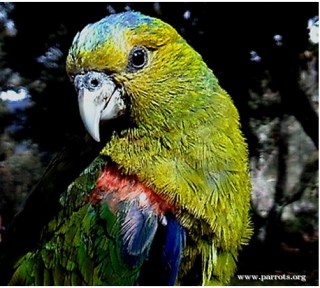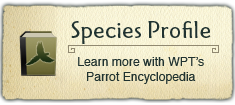Project Regions:
Indigo-winged Parrot |
|
|
Collaborators/Funders
American Bird Conservancy (ABC), Fundacion ProAves Colombia, Fundacion Natura, Conservation International, British Natural History Museum, Instituto de Ciencias Naturales - Universidad Nacional de Colombia
Long-lost parrot rediscovered in 2002
The Indigo-winged Parrot (Hapalopsittaca fuertesi) population numbers 230-300 birds.
Project progress: In 2001 WPT and the American Bird Conservancy provided initial funding for Fundacion ProAves from Colombia to mount a search for these birds and to study a related species, the Rusty-faced Parrot. The research team's next goals were to:
- Determine habitat requirements
- Research food preferences
- Find vital nesting cavities
- Locate other flocks in the region
Outcomes: The team was able to locate 14 birds initially, and subsequent surveys and intensive conservation action have boosted the wild population to nearly 300. It is protected in Acaime and Cañon del Quindío Natural Reserves. An area of 631 ha of core habitat was recently acquired by Fundación ProAves with the support of various organizations. Another 300 ha area, the Giles-Fuertesi Bird Reserve located in Cajamarca, was also recently created. Research in this area will center on the species' habitat use, behaviour and reproduction, with the ongoing use of nest boxes, which have been very successful in increasing breeding success. More boxes will be constructed to provide enough sites to allow success to continue, and reduce competition from other species. Environmental education programmes are also being utilized to spread awareness in local communities.
Wild population: 230-300
Where found: In Cordillera Central, below Nevado de Santa Isabel, W Colombia.
History: The Indigo-winged Parrot lives only on the west slope of the Central Andes of Colombia near the border of Quindío, Risaralda and Tolima. The last known sighting of the species was in 1911. The species was rediscovered by Fundación ProAves in mountain forest in Génova municipality, Quindío Department. In July 2002, the first confirmed sighting was made in the central Andes, close to Los Nevados National Park, when 14 birds were located in a small area of forest (Parr and Gilardi 2002). Intensive conservation and protection efforts have boosted the population to nearly 300, thanks to a 87% hatching success and 95% fledging success amongst breeding birds in the Central Cordillera (Anon 2006).
Threats:
- Habitat loss due to clearance for logging
- Lack of nest sites, restricting breeding
- Threat increasing against the small remaining habitat
Ecology: The habits of this parrot are poorly known, but research undertaken since 2003 has revealed some information on the species' breeding and feeding ecology. It tends to inhabit cloud-forest betweeen 2600 and 3600m, and is known to require mistletoe berries as a food source. Nesting takes place between January and May.


































